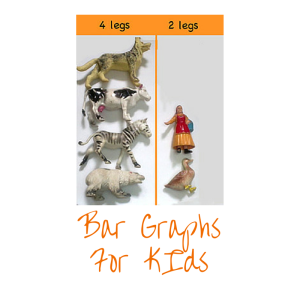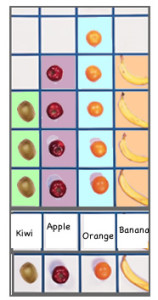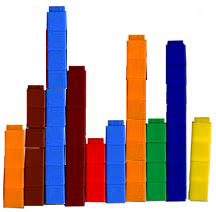Introduce graphs for kids by starting with the simple bar graph. The height of each bar gives information, helping the children notice which columns have more objects and which columns have fewer objects. Bar graphs also help children sort and organize information.
Stage one – Just like teaching any concept to this age group, children learn as they describe, explain, and consider ideas with real objects. The concept of bar graphs begins with hands on experiences and using objects that the children have previously had time to play with and explore. Open investigation and exploration and time for questions and discussions are required.
Stage two – Once the children understand the concept of making a bar graph with real objects they are ready for the introduction of pictures that represent the real objects and making graphs with the pictures.
Stage three – Children can be introduced to the idea of using words, numbers or symbols to represent the data collected. This does not happen in the early grades.
Keep it Simple!

One key to teaching bar graph concepts to preschool and kindergarten kids is to remember you are starting at stage one and focusing on introducing the concepts and vocabulary.
As my mentor teacher said when I was a student teacher, “Keep it simple – take what you think you’ll teach in a lesson and spread it out over a couple of weeks!”
Bar Graphs for Kids – Vocabulary
Making the term “bar” meaningful to a child
- For most kids the word “bar” will represent food, such as a chocolate bar or a granola bar.
- Most children will understand that a bar usually means a long rectangular shape.
- Using a colored, rectangular paper behind real objects helps children visualize a bar.
- Providing children with plenty of exploratory time with Cuisenaire™ rods or Unifix™ cubes and having them create short “bars” and long “bars” will solidify the term.
Game to Introducing a Graph Vocabulary
Purpose of game: To build concepts of the terms “bar, column and row”.
Materials:
- Real things – four categories of fruit
- Four fruit word cards
- A graphing mat spread on the floor
- Four different colors of square papers, each the size of the graph squares (they will help the children see columns)
- Tape and name tags or sticky name tags
Before Lesson:
In this lesson, the children’s parents were asked to send any one of four fruits listed in a letter home. The teacher provided one of each and a few extra for the children whose parents forget.

Procedure:
- Talk about what a graphing mat is and how it can quickly help us see whether we have more or fewer things.
- Children stick a name tape on their fruit
- Teacher places a piece of real fruit and a word card in the top or bottom box of each row on a graphing mat which is on the floor.
- Children tape a piece of colored paper and place their piece of fruit in the correct column
- Teacher removes the fruit from the bottom row
- Teacher and children discuss which column has more, has less, and how many in each column
- Teacher or child prints the number on a card and places it under the word card.
- Children enjoy eating their fruit and teacher focuses their attention on the colored papers that are left on the mats at this time. What do they look like? Which column or bar of colored paper is longer or shorter?
- Children record what was significant to them about the experience with drawings and words they can sound out.

Any real things work for this lesson. It is tempting to want to teach it all and to jump into picture and symbolic graphs quickly but it is better to wait and give the children plenty of experiences with real graphs first.
Bar Vocabulary game
Purpose of game: To build a concept of the term “bar”, as it will be used in a bar graph.
Materials:
- a pile of Unifix™ cubes
- a timer
- a long ruler or yardstick
Procedure:
- Children sit in a circle with a pile of Unifix™ cubes in front of each child.
- Each child makes a bar using only one color of cube, depending on the teacher’s command.
- For example, the teacher might say to the children:
- Make a bar with less than 10 cubes OR Make a bar with more than 2 cubes
- Or use a use a timer and children attach cubes until it rings.
- Next have the children, a few at a time, slide their their bars carefully in a line as in the image above. A yardstick/meter stick helps kids to line them up neatly
- Then ask: How could we sort the bars?
- A child might answer, “Sort from shortest to tallest”.
- Children take turns moving their bars into position of shortest to tallest (sounds simple but may take a while!!).
- Teacher can continue questions – Are there more short bars or are there more long bars? How many children made tall bars? red bars? bars with four cubes? How many children made bars with fewer than 5 cubes?
- Ask again, “Is there another way we can sort the bars?” and repeat the sequence above.
Graphing Mat Materials
This graphing mat has a blue grid on one side and a 4 x 12 array on the reverse.
The mat measures 24 x 72 inches.
These are great for graphing small objects or for picture graphs. I also like them for activities that involve sorting, such as sorting animals pictures by mammal, reptile, bird, fish, etc.
Activities for graphing mats by Patricia Cartland Noble



